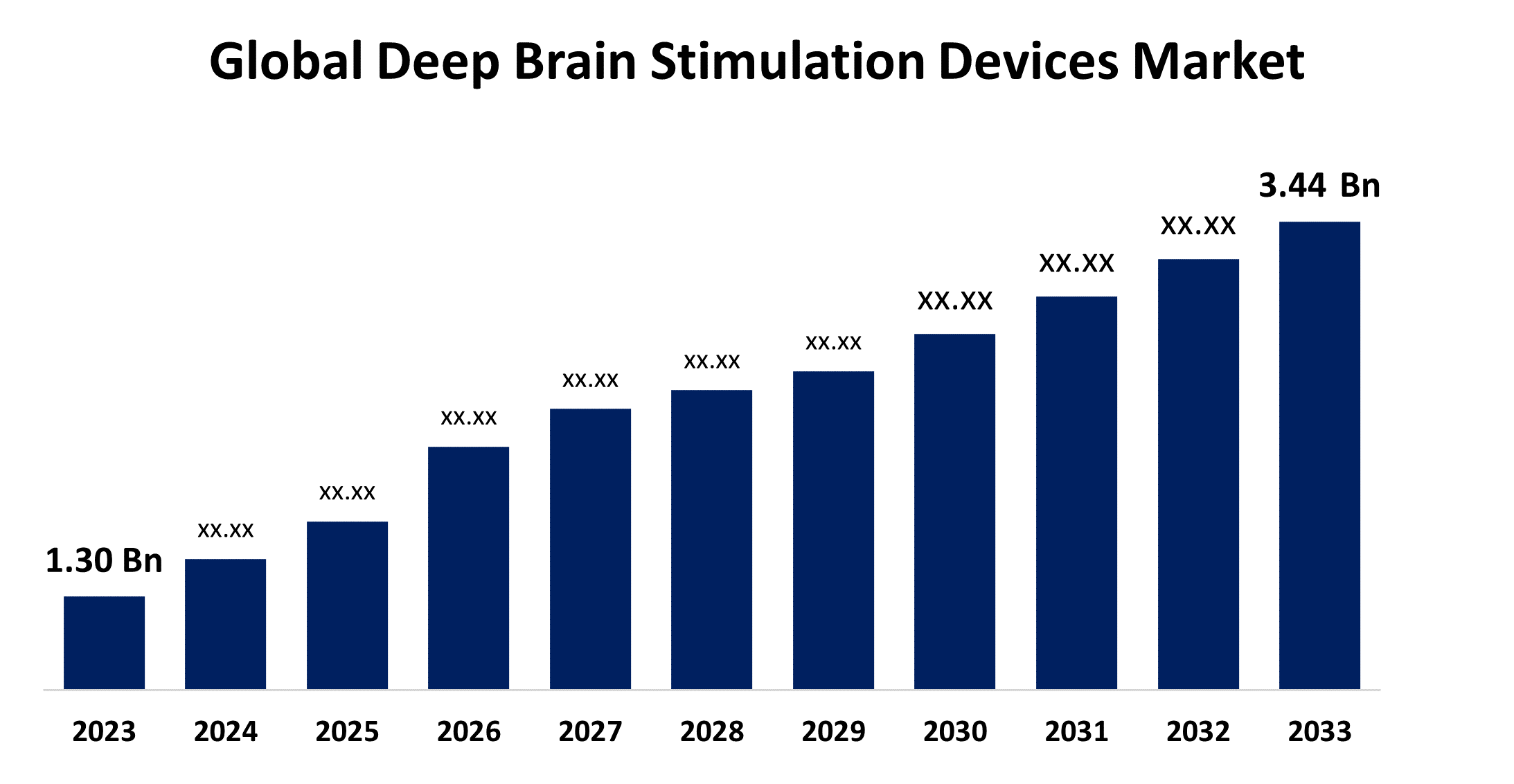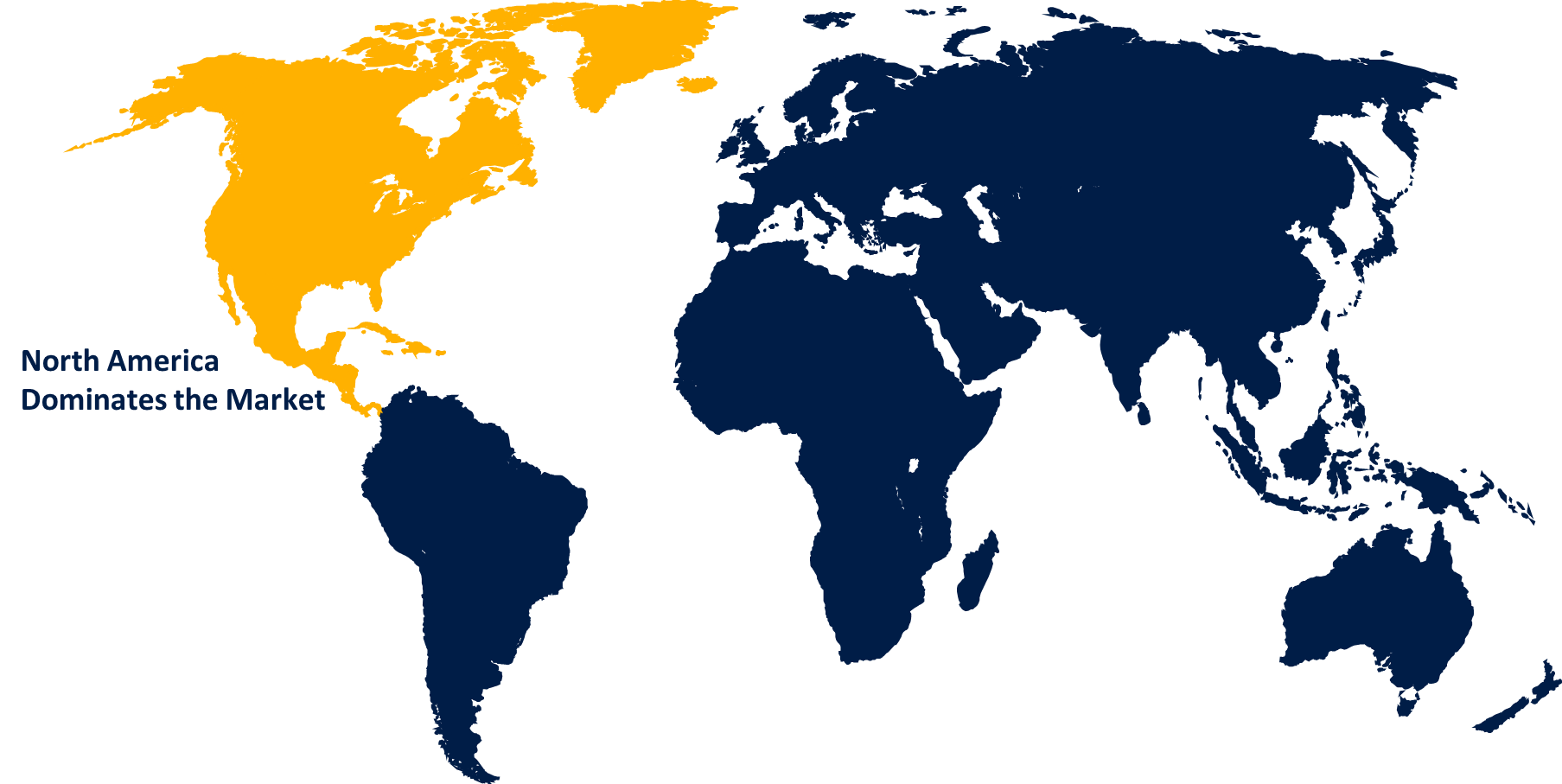Global Deep Brain Stimulation Devices Market Size, Share, and COVID-19 Impact Analysis, By Product (Single-channel, and Dual-channel), By Application (Parkinson’s Disease, Epilepsy, Dystonia, and Essential Tremor), By End User (Hospitals, Neurology Clinics, Ambulatory Surgical Centers, Research Centers), and By Region (North America, Europe, Asia-Pacific, Latin America, Middle East, and Africa), Analysis and Forecast 2023 - 2033
Industry: HealthcareGlobal Deep Brain Stimulation Devices Market Insights Forecasts to 2033
- The Global Deep Brain Stimulation Devices Market Size was Valued at USD 1.30 Billion in 2023
- The Market Size is Growing at a CAGR of 10.22% from 2023 to 2033
- The Worldwide Deep Brain Stimulation Devices Market Size is Expected to Reach USD 3.44 Billion by 2033
- Asia Pacific is Expected to Grow the fastest during the forecast period.

Get more details on this report -
The Global Deep Brain Stimulation Devices Market Size is Anticipated to Exceed USD 3.44 Billion by 2033, Growing at a CAGR of 10.22% from 2023 to 2033.
Market Overview
Deep brain stimulation (DBS) is a treatment that uses an implanted device to send an electrical current directly to specific parts of the brain. The electrodes generate electrical impulses that influence brain function to cure certain medical disorders. Electrical impulses can also influence cells and molecules in the brain, resulting in medical disorders. A pacemaker-like device implanted beneath the skin in the upper chest regulates the amount of stimulation during deep brain stimulation. A wire that goes beneath the skin connects this gadget to the electrodes in the brain. It is most commonly used for disorders like Parkinson's disease and epilepsy, but researchers are researching if it can assist with many other conditions as well. According to the World Health Organisation, more than 3 billion people worldwide are living with a neurological condition.
Report Coverage
This research report categorizes the market for the deep brain stimulation devices market based on various segments and regions forecasts revenue growth and analyzes trends in each submarket. The report analyses the key growth drivers, opportunities, and challenges influencing the deep brain stimulation devices market. Recent market developments and competitive strategies such as expansion, product launch, and development, partnership, merger, and acquisition have been included to draw the competitive landscape in the market. The report strategically identifies and profiles the key market players and analyses their core competencies in each sub-segment of the deep brain stimulation devices market.
Global Deep Brain Stimulation Devices Market Report Coverage
| Report Coverage | Details |
|---|---|
| Base Year: | 2023 |
| Market Size in 2023: | USD 1.30 Billion |
| Forecast Period: | 2023-2033 |
| Forecast Period CAGR 2023-2033 : | 10.22% |
| 2033 Value Projection: | USD 3.44 Billion |
| Historical Data for: | 2019-2022 |
| No. of Pages: | 213 |
| Tables, Charts & Figures: | 110 |
| Segments covered: | By Product, By Application, By End User, By Region |
| Companies covered:: | Abbott, Medtronic, Neuropace Inc., Renishaw Plc., Beijing Pinchi Medical Equipment Co. Ltd, Boston Scientific Corporation, Nexstim, LivaNova Plc, Aleva Neurotherapeutics S.A., and Others Key Vendors. |
| Pitfalls & Challenges: | COVID-19 Empact, Challenges, Future, Growth, & Analysis |
Get more details on this report -
Driving Factors
The deep brain stimulation (DBS) market is driving due to several key factors. These include the increasing prevalence of neurological disorders, advancements in DBS technology enhancing its safety and efficacy, growing awareness and acceptance of DBS among patients and healthcare professionals, rising healthcare expenditure and favorable reimbursement policies, expanding applications of DBS beyond Parkinson's disease, improved patient outcomes, and substantial investments in research and development driving innovation. These factors collectively contribute to the growth and expansion of the DBS market worldwide.
Restraining Factors
The effectiveness of deep brain stimulation in the market is hindered by several factors. Surgical risks, including infection and stroke, accompany the procedure, battery life, maintenance, cost, and Accessibility, while potential side effects like cognitive changes and mood distances pose challenges. Financial constraints might limit access to this costly treatment, and its applicability is restricted by specific criteria. Psychosocial impacts on patients and families, along with ethical considerations, further complicate DBS therapy.
Market Segmentation
The deep brain stimulation devices market share is classified into product, application, and end-user.
- The dual-channel segment dominates the market with the largest market share through the forecast period.
Based on the product, the deep brain stimulation devices market is categorized into single-channel and dual-channel. Among these, the dual-channel segment dominates the market with the largest market share through the forecast period. The dual-channel segment's dominance in the worldwide deep brain stimulation devices market indicates that this technology is preferred by consumers and healthcare practitioners alike. Dual-channel devices might deliver more accurate and customized stimulation, perhaps improving therapy outcomes for individuals with neurological illnesses. Furthermore, developments in dual-channel technology might meet specific needs and obstacles in treating illnesses such as Parkinson's disease and essential tremors, which will increase their popularity.
- The Parkinson’s disease segment is anticipated to hold the highest share through the projected period.
Based on the application, the deep brain stimulation devices market is categorized into Parkinson’s disease, epilepsy, dystonia, and essential tremor. Among these, the Parkinson’s disease segment is anticipated to hold the highest share through the projected period. Parkinson's disease is expected to dominate the deep brain stimulation devices market because of its prevalence and severity, as well as the effectiveness of DBS as a therapy option. Parkinson's disease is a degenerative ailment that has a substantial impact on motor function and quality of life for millions of people worldwide. Additionally, ongoing technological advancements and clinical innovations might further enhance the applicability and effectiveness of deep brain stimulation in addressing the complex needs of Parkinson's patients, solidifying its position as a cornerstone in the management of this debilitating condition.
- The hospitals segment accounted for the largest revenue share through the forecast period.
Based on the end-user, the deep brain stimulation devices market is categorized into hospitals, neurology clinics, ambulatory surgical centers, and research centers. Among these, the hospitals segment accounted for the largest revenue share through the forecast period. The hospital category is expected to dominate due to the prevalence of cutting-edge facilities throughout hospital settings. Furthermore, deep brain stimulation surgeries necessitate high precision and prompt medical attention when required. As a result, the availability of the aforementioned variables promotes hospital segment growth in the deep brain stimulation devices market.
Regional Segment Analysis of the Deep Brain Stimulation Devices Market
- North America (U.S., Canada, Mexico)
- Europe (Germany, France, U.K., Italy, Spain, Rest of Europe)
- Asia-Pacific (China, Japan, India, Rest of APAC)
- South America (Brazil and the Rest of South America)
- The Middle East and Africa (UAE, South Africa, Rest of MEA)
North America is anticipated to hold the largest share of the deep brain stimulation devices market over the predicted timeframe.

Get more details on this report -
North America is projected to hold the largest share of the deep brain stimulation devices market over the forecast period. This is due to the expansion of healthcare research and development operations, which has resulted in a surge in advances in the field. Major organizations in the sector have a strong presence in the United States, which will assist the market growth. The increasing prevalence of neurological illnesses, high R&D spending, product approvals from the US Food and Drug Administration (FDA), and technological developments are all important drivers driving market growth in North America.
Asia Pacific is expected to grow at the fastest CAGR growth of the deep brain stimulation devices market during the forecast period. The Asia Pacific deep brain stimulation market will also benefit from increased public knowledge of various neurological illnesses such as epilepsy, essential tremors, and Parkinson's disease. The increased availability of medical facilities, such as multispecialty hospitals and specialty clinics, is a significant development driver. The growing number of neurologists and other medical professionals working in the Asian market is a major driving market growth. Expanding demand in countries like Japan, China, and India, the Asia Pacific region's market value is expected to grow the fastest. Rising disposable incomes in the region have resulted in rising healthcare expenditures.
Competitive Analysis:
The report offers the appropriate analysis of the key organizations/companies involved within the deep brain stimulation devices market along with a comparative evaluation primarily based on their product offering, business overviews, geographic presence, enterprise strategies, segment market share, and SWOT analysis. The report also provides an elaborative analysis focusing on the current news and developments of the companies, which includes product development, innovations, joint ventures, partnerships, mergers & acquisitions, strategic alliances, and others. This allows for the evaluation of the overall competition within the market.
List of Key Companies
- Abbott
- Medtronic
- Neuropace Inc.
- Renishaw Plc.
- Beijing Pinchi Medical Equipment Co. Ltd
- Boston Scientific Corporation
- Nexstim
- LivaNova Plc
- Aleva Neurotherapeutics S.A.
- Others
Key Target Audience
- Market Players
- Investors
- End-users
- Government Authorities
- Consulting And Research Firm
- Venture capitalists
- Value-Added Resellers (VARs)
Recent Developments
- In April 2024, Medtronic announced the Advanced NeuroSmart Portable MER Navigation System in India to manage Parkinson's disease with deep brain stimulation procedures.
- In January 2024, Abbott recently announced that it had received approval from the US Food and Drug Administration (FDA) to launch the Liberta RC deep brain stimulation (DBS) system—the "world's smallest" rechargeable DBS device with remote programming, according to the company—to treat people suffering from movement disorders.
- In January 2024, Medtronic received FDA approval for its Percept RC deep brain stimulation (DBS) device for patients with movement disorders such as Parkinson's disease, essential tremor, and dystonia, as well as epilepsy.
Market Segment
This study forecasts revenue at global, regional, and country levels from 2023 to 2033. Spherical Insights has segmented the deep brain stimulation devices market based on the below-mentioned segments:
Global Deep Brain Stimulation Devices Market, By Product
- Single-channel
- Dual-channel
Global Deep Brain Stimulation Devices Market, By Application
- Parkinson’s Disease
- Epilepsy
- Dystonia
- Essential Tremor
Global Deep Brain Stimulation Devices Market, By End User
- Hospitals
- Neurology Clinics
- Ambulatory Surgical Centers
- Research Centers
Global Deep Brain Stimulation Devices Market, By Regional Analysis
- North America
- US
- Canada
- Mexico
- Europe
- Germany
- UK
- France
- Italy
- Spain
- Russia
- Rest of Europe
- Asia Pacific
- China
- Japan
- India
- South Korea
- Australia
- Rest of Asia Pacific
- South America
- Brazil
- Argentina
- Rest of South America
- Middle East & Africa
- UAE
- Saudi Arabia
- Qatar
- South Africa
- Rest of the Middle East & Africa
Frequently Asked Questions (FAQ)
-
1.What is the CAGR of the deep brain stimulation devices market over the forecast period?The deep brain stimulation devices market is projected to expand at a CAGR of 10.22% during the forecast period.
-
2.What is the market size of the Deep Brain Stimulation Devices Market?The Global Deep Brain Stimulation Devices Market Size is Expected to Grow from USD 1.30 Billion in 2023 to USD 3.44 Billion by 2033, at a CAGR of 10.22% during the forecast period 2023-2033.
-
3.Which region holds the largest share of the deep brain stimulation devices market?North America is anticipated to hold the largest share of the deep brain stimulation devices market over the predicted timeframe.
Need help to buy this report?